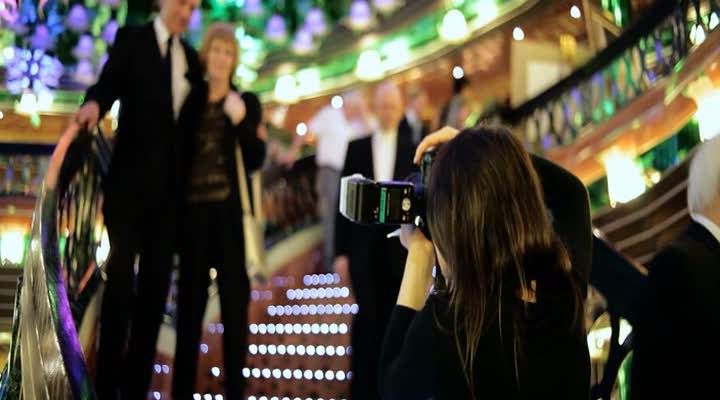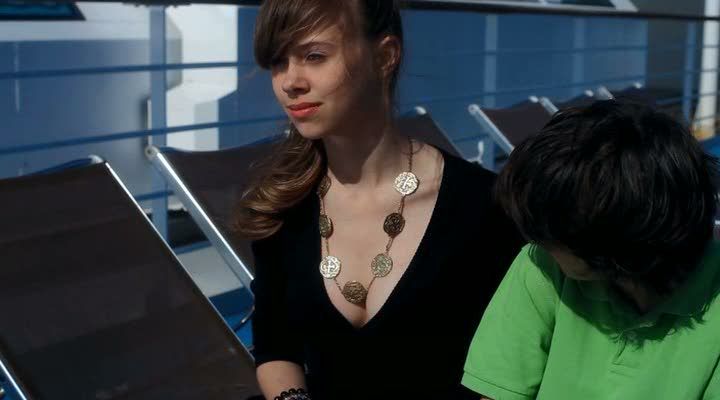
Take 1, because Film Socialisme is not a film that offers up its ideas easily, because Jean-Luc Godard, in his latest film and first feature since 2004's Notre musique, is typically opaque and elusive. Take 1, also, because Godard, trickster that he is, released this latest opus to the English-speaking world in a way deliberately designed to make it even more difficult for those who don't speak the film's many languages. The film's dialogue and monologues are in French, Russian, German, Arabic, and other languages, but only an occasional isolated phrase of English. And Godard's chosen subtitles are in what the director has playfully dubbed "Navajo English," minimalist strings of disconnected words, not so much translating the dialogue as providing snippets of meaning, hints at the full meaning of what's being said. The subtitles are less translations than messages to the audience, enigmatic epitaphs that translate not speech but the deeper subtexts of Godard's cinema. The subtitles are a kind of passive-aggressive joke on American audiences, because America and its influence is the film's subtext — for the most part, Godard avoids explicitly mentioning America so assiduously that it becomes the unspoken ghost within the film, the driving force for everything that happens, the hidden target of so many of the film's satirical jabs.
And what is this but a satire? A satire of America, of capitalism, and also of the whole idea of cinematic storytelling. The film is divided into three segments. The first is set on a cruise ship, visiting various locales that have resonance to Godard — Barcelona, Naples, Odessa, Hellas ("Hell As," and also hélas, as in "alas," as in Godard's Hélas pour moi), Egypt, Palestine ("Access Denied," the onscreen text simply reads at this last port of call) — and never venturing beyond the superficial surfaces of anything. The images are glossy and pristine, bright and beautiful, parodies of cinematic splendor that are both jaw-droppingly sublime and yet somehow empty, suggesting how little beauty counts for amidst all this silly opulence. The film is obsessed with gold, with money. The cruise passengers play slots, their mechanically pumping arms highlighted against a gorgeous seascape. A Christian mass is held in a dining room with a bar nearby and a crystal ball rotating overhead, projecting fragmented mirror images of the ceremony. Snatches of conversation, partially translated or not, are concerned with business deals, with history (Hitler, Stalin, Communism, wars civil or otherwise), with seeming plots and spy maneuvers.
This baffling, elliptical verbal chatter is juxtaposed against the images of the cruise ship's conspicuous consumption: dance clubs where the music is distorted into a noisy clamor, passengers watching workout videos and cinematic images of Arabs interchangeably, people lounging around, eating, staring out at the sea. What better place than a cruise ship for Godard to document the victory of capitalism and the death of socialism: it is a place where capitalism's virtue is assumed, where every image, every setting demonstrates the capitalist's ascendancy. To the extent that there are distinguishable characters in this section of the film, they are symbols and metaphors rather than actual individuals. So Godard pays special attention to the glowing glamor of this setting, but does so in ways that call attention to power relations and the subtexts of the capitalist system as it's incarnated here. One shot from early in the film shows a couple of passengers posing for a photo on a typically glitzy staircase, surrounded by bright lights. But the image is out-of-focus; only the photographer in the foreground, presumably a cruise ship employee, is in focus, while the rest of the image is deliberately blurred and indistinct, an abstract image of privilege and success rather than a concrete portrait of two particular people. The composition calls attention to the worker taking the picture rather than the photo's ostensible subjects.

The film's second section shifts to a rural setting and focuses more concretely on a single family. The fragmentary pacing and flashy aesthetics of the cruise ship segment give way to a slower, more patient pace and an emphasis on domesticity and routine. This family, the Martins, owns a gas station and is apparently involved in an important election. They are dogged by a pair of journalists with a movie camera, who hover around the gas station accosting anyone who walks by, trying to get interviews and images. The fragmentary dialogue of the film's first part is replaced by lengthier dialogues, which makes the incomplete "Navajo" translation more of an issue: during the cruise ship passage, the Navajo subtitles mirrored the jumpy editing and the collaging of hi-definition digital images with grainy video footage. Here, the subtitles really do feel like out-of-context fragments ripped out of a larger whole, and it becomes even more apparent that Godard intends for language-deficient Americans to understand only incompletely, to be denied the full meaning of the dialogues.
But this confrontational pose is balanced by moments of humor and playfulness, particularly in the form of the Martins' young blonde son, a sprite who incarnates Godard's still-youthful sense of humor. This boy, dressed in a red CCCP shirt decorated with the Soviet hammer and sickle, conducts the classical music of the soundtrack, wildly swinging a lead pipe through the air in response to the music. Later, in his sleep, the movements of his mouth and the twitch of his fingers respond to — or perhaps produce — the plucking bass of a jazz tune. This boy chases off the TV reporters with his pipe, swinging it like a sword, playing pirate. He feigns blindness and runs his hands along his mother's body, creating an image of her in his mind with his fingers. He paints a Renoir masterpiece, and Godard's camera looks over his shoulder, distorting the image with digital color manipulation, as the boy looks at the young black camerawoman in her bikini top but paints a Renoir scene of pastoral beauty. The manipulated, blown-out colors make the whole image look like a painting, artificial and distancing.

Godard seems to be suggesting that art distorts, art lies, art dodges reality: the disconnect between what the boy is looking at and what he's painting suggests that the art of the past, like Renoir's landscapes, is a way of avoiding engagement with the present, with what's directly in front of us. What we need is an art of the present, an art that engages with reality as it really is. Earlier, on the cruise ship, one of the wealthy passengers wound through a gallery crowded with paintings, all of them for sale, all of them representing a classical style from the past, and images from the past. The glorification of the past, the obsession with masterpieces and masters, is interwoven with commerce, with the value of art in terms of money. Godard's more interested in the present, in images that are aware of history but point towards people and things that are happening now. Thus the second section, with its emphasis on the slow rhythms of daily life — brushing one's teeth, reading a book, children playing, halting conversations between members of the family — locates Godard's ideas within the context of the family, the context of prosaic reality rather than the stylized confines of art.
In the film's final section, Godard adopts an essayistic style to return to the locales of the cruise ship's journey: Egypt, Palestine, Hellas, Naples, Barcelona. For the cruise ship, these were simply destinations, brief stopovers, their rich histories obscured by the tourist's gloss. Godard returns to them here by pulling images from newsreels and films, images of art and photographs of history mashed up alongside cinematic excerpts. He's examining the disjunctions between past and present, nowhere so obviously as when he cuts between the Odessa Steps sequence from Eisenstein and the modern-day Odessa Steps, a tourist attraction where groups of schoolchildren gather on the steps that were once the site of both a real massacre and its cinematic representation. It's during this section, especially, that Godard's insistence on denying meaning and translation render any understanding of the film conditional and ephemeral.

But, one suspects, that is the nature of the film in general, even for those rare individuals who "understand" all its many languages perfectly, who don't require any translation. Film Socialisme is dense and challenging, beautiful and provocative, allusive and elusive, bursting with so many ideas and suggestions that it defies the possibility of the kind of complete reading that one generally expects from a movie. In its very structure, the film is making a statement, more even than any Godard film before it, that the idea of complete understanding is an absurd joke.
Take 2, of perhaps many more, follows here. Understanding will come, if at all, much later.







0Awesome Comments!